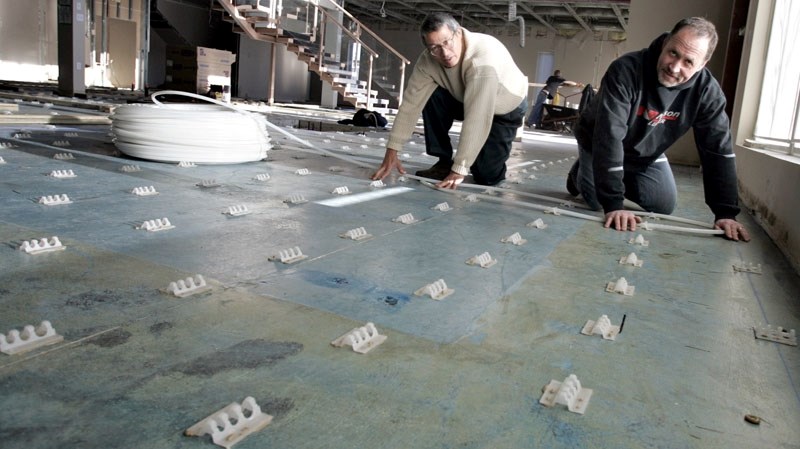Anyone who wants a cheaper energy bill should call Stephen Khan. The former St. Albert MLA has had a geothermal heating system in his home since 2008, and says it works great.
Khan says he got the system to avoid high natural gas prices. It’s been extremely reliable, requiring little maintenance and continuing to work even when his basement flooded in 2012.
“It wasn’t cheap,” he says of the system, but he’s saved enough on his energy bills that he expects to make back his incremental costs in a few years. Plus, he’s not using any natural gas for heating.
“You link that to the environmental benefits, and it’s a good feeling.”
St. Albert’s Leigh Bond works with many types of renewable energy systems at Think Mechanical, and installed the system at Khan’s home.
Bond says residential geothermal systems are called ground-source heat pumps, of which there are about 2,200 in Alberta. These pumps are more or less refrigerators for your home.
To make one, you drill a bunch of holes, drop a radiator-like loop of pipes into it, and fill those pipes with water. These pipes are below the frost line, so they won’t freeze.
“Forty-six per cent of the sun’s radiant energy is absorbed into the top 500 feet (of the Earth) on a continuous basis,” Bond says – that’s enough energy to keep the soil at about 6 C year round.
The water in the pipes pulls about three degrees of heat out of the ground and dumps it into a second pipe loop full of refrigerant. Compressors squeeze the refrigerant to amp it up to 65 C, producing the heat you need to warm your air and water. You can also run the system in reverse to cool your home.
Geothermal is the most efficient way to heat and cool a building, says Jacob Komar of the Green Energy Alliance of Alberta. Since it pulls in free heat from the ground, you get more heat out of it than you put in energy to run it. Most geothermal systems can be 350 to 600 per cent efficient as a result, compared to just 96 per cent for natural gas.
“In terms of efficiency, you can’t beat it.”
This high efficiency means lower bills and lower greenhouse gas emissions. Even with Alberta’s current coal-heavy grid (where electricity is about 734 g of CO2 per kWh), Bond calculates that a geothermal-heated home will produce about 46 per cent less greenhouse gas emissions per year than one heated by natural gas.
“That’s the magic.”
But geothermal has some hefty drawbacks. You need a certain size of yard to do it, for example, and you have to tear up your yard (and possibly floors) to install it, Bond says. You also need a skilled installer – design the system wrong, and your pipes will pull too much heat out of the ground and freeze it.
The biggest drawback is the price. Komar says a geothermal system costs about $15,000 to $20,000 more than a natural gas one (which runs for about $25,000). At current natural gas prices, that means it’ll take about 15 to 18 years for you to make your money back.
“With today’s current natural gas prices, that’s tougher to justify.”
But natural gas isn’t going to stay cheap forever, Bond notes. Add in the $1.68/GJ carbon tax that Alberta is supposed to get by 2018 (as recommended by the province’s Climate Leadership report), and the payback for a geothermal system drops to about eight years.
“When that (tax) takes effect, my phone will ring off the hook.”
And unlike natural gas, geothermal will produce fewer and fewer emissions as the power grid gets greener, Komar and Bond note. Pair it with wind or solar power, and it becomes zero-emission.
Geothermal makes the most sense for commercial buildings, Komar and Bond say. These structures need more cooling than homes, which makes for a faster payback – instead of replacing cheap gas with electricity, you’re replacing electricity with less electricity. It’s also more cost-effective to dig a bunch of holes at once for a big building instead of a few at a time for a house.
The federal government also offers big tax breaks for commercial geothermal systems, Bond notes. The payback for the system in Morinville’s 100 Block West complex could be as short as three years as a result.
Geothermal makes economic sense for anyone who plans to stick around in a home for awhile, Khan says.
“The most remarkable thing about it is that it’s kind of unremarkable,” Khan said – they have a warm house in the winter and a cool one in the summer.
“Our house is very comfortable, and it just works.”
Carbon Tracker
Step: Replace a natural gas furnace with a geothermal system.<br />Difficulty: Hard.<br />Cost: $15,000 to $20,000 more than a regular furnace ($45,000 total).<br />Payback Period: 15-18 years residential. Substantially less for commercial.<br />Carbon Saved: 10.2 tonnes/yr. for a typical home – a 46 per cent reduction.
The Carbon Challenge
The Carbon Challenge will profile different ways you can shrink your carbon footprint and (usually) save money every second week. <br />Got a carbon question? Drop me a line at [email protected].




